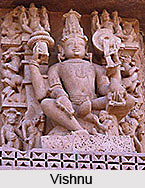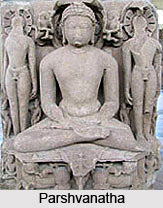 The Khajuraho temples were dedicated to Vishnu, Shiva, Surya, and the Yoginis. The Khajuraho artists have created some extraordinary images of these divinities, which express deep philosophical concepts.
The Khajuraho temples were dedicated to Vishnu, Shiva, Surya, and the Yoginis. The Khajuraho artists have created some extraordinary images of these divinities, which express deep philosophical concepts.
Vishnu: Although all the ten standard avataras of Vishnu are represented at Khajuraho, only Vishnu himself, and three of his avataras, are enshrined in the temples. These are Varaha, Vamana, and Vaikuntha. Hayagriva, the horse-necked avatara associated with learning, which saves the Vedas from the demons, is placed in cardinal niches of the Lakshmana and the Vamana temples. Among the great images at Khajuraho are those of Vishnu as Yogeshvara, seated in the padmasana posture, giving discourse to sages, placed in the upper cardinal niches of the Lakshmana temple Vishnu making a gesture of silence with his forefinger near his lips.
 Shiva: As in the case of other Shiva temples, the sign of Shiva, the linga, is enshrined in the centre in the sanctum sanatorium. Shiva`s manifestations are placed in the three cardinal niches of the sanctum, in the hall, and on the exterior walls of the temple. All manifestations of Shiva are represented at Khajuraho. These are: Natesha (Cosmic Dancer), Kalyana-Sundara (Bridegroom), Ardhanarishvara (Androgyn), Uma-Maheshvara (seated with Uma), Uma-Alingana Murti (embracing Uma in a standing posture), Andhakasuravadha Murti (slaying the Blind Demon), Tripurantaka (vanquishing the three cities of demons), Bhairava, the fierce aspect, and others.
Shiva: As in the case of other Shiva temples, the sign of Shiva, the linga, is enshrined in the centre in the sanctum sanatorium. Shiva`s manifestations are placed in the three cardinal niches of the sanctum, in the hall, and on the exterior walls of the temple. All manifestations of Shiva are represented at Khajuraho. These are: Natesha (Cosmic Dancer), Kalyana-Sundara (Bridegroom), Ardhanarishvara (Androgyn), Uma-Maheshvara (seated with Uma), Uma-Alingana Murti (embracing Uma in a standing posture), Andhakasuravadha Murti (slaying the Blind Demon), Tripurantaka (vanquishing the three cities of demons), Bhairava, the fierce aspect, and others.
The most important of all these is the Sadashiva, who is the pivot of the iconic scheme of the Kandariya Mahadeva temple. Two unique sculptures of Sadashiva at Khajuraho depict him with four feet (chatushpadas).
Brahma: The so-called `Brahma` temple originally was a Vishnu temple. Brahma however has a place as a subsidiary figure in both Vishnu and Shiva temples.
Surya: The Sun god is shown in human form, generally standing in samabhanga, wearing shoes and dressed like a northerner. He holds a lotus in each of his hands. Seven horses are depicted as pulling his chariot. At Khajuraho, there is a separate shrine dedicated to Surya, now called the Chitragupta temple.
 Parvati/Uma: Goddess, daughter of Parvata (mountain) and wife of Shiva. Her independent images show her performing tapas (penance), with an iguana as her mount. Her colossal image in the Museum indicates that it must have once been enshrined in a temple.
Parvati/Uma: Goddess, daughter of Parvata (mountain) and wife of Shiva. Her independent images show her performing tapas (penance), with an iguana as her mount. Her colossal image in the Museum indicates that it must have once been enshrined in a temple.
Yoginis: The sixty-four Yoginis were worshipped collectively in an open-air granite sanctuary at Khajuraho.
Durga: The warrior goddess is shown as slaying Mahishasura, the buffalo demon, accompanied by her mount, a lion. The image in the principal cell of the Chausath Yogini temple, but now it is in the open-air Museum of the ASI).
Karttikeya: Son of Shiva and Parvati, Karttikeya is considered a war god. However at Khajuraho, a unique depiction of him as a teacher of grammar is found and he is also shown holding a manuscript in one hand.
Ganesha: Ganesha has many images at Khajuraho, and is found in almost all the temples. He is generally represented in a dance posture or is shown seated or standing, with a rat as his mount.
The Seven Matrikas: The Mothers, represented collectively at Khajuraho, in their respective order are: Brahmani, Maheshvari, Kaumari, Vaishnavi, Varahi, Aindri, and Chamunda. They are generally shown as dancing, seated, or standing on door lintels, jambs, and niches of temples. Shiva in the form of Virabhadra, and Ganesha accompanies them.

The Nava Grahas: The nine planets are shown standing or seated on the door headers of the sanctums of temples of all sects, including the Jain temples.
The Jain Tirthankaras and Divinities: The Jain temples of Khajuraho are associated with the Digambara sect. Here, there are images of Jinas or Tirthankaras, Yakshas and Yakshis, who are guardian deities (shosana`devatos) subservient to the Jinas, and who grant the mundane wishes of devotees, Vidyadevis (goddesses of knowledge), Kshetrapalas, and other deities such as Grahas and Dikpalas, as in the Hindu temples.
Jinas or Tirthankaras: The Jina or Tirthankara images are the nucleus of the Jain temples. There are as many as two hundred images of Jinas at Khajuraho. Of the twenty-four Jinas, at least fifteen are represented here Adinatha or Rishabhanatha, the first Jina, is depicted the maximum times, he appears in almost sixty images. Twenty images of the 23rd Jina, Parashvanatha is also found. Mahavira, the twenty-fourth Jina, in nine, and Shantinatha, the sixteenth Jina, has four images, one of which is 4.3 meters (14 ft.) tall. At Khajuraho, they are shown seated on simhasana (lion`s seat), provided with cushions, and sheltered by an umbrella, the symbol of (spiritual) sovereignty and attended by flywhisk bearers. There is an elaborate pantheon, an assembly of celestial beings, surrounding the figures of the Jina.
 Yakshas and Yakshis: They are depicted as richly adorned, and smaller in size than the Jina whom they serve. At Khajuraho, the images of Chakreshvari, Ambika, and Padmavati, the Yakshis of Adinatha, Neminatha, and Parshvanatha respectively, are found in large numbers. Chakreshvari is found at the centre of door lintels of the temples. Chakreshvari is depicted as a counterpart of the Hindu goddess Vaishnavi. She holds a discus (chakra) in her hand and rides the mythical bird, the Garuda. The Yakshi Ambika, shaded under a mango tree, holds a child and a bunch of mangos. A snake distinguishes Padmavati over her head. Among the Yakshas, the Sarvanubhuti (Kubera) and Gornukhahave have several representations at Khajuraho. The Yaksha couple with a child, called `Parents of Jina`, sits below a tree, surmounted by the figure of a Jina. This sacred pair seems to have been elevated to independent niches in the Jain temples, as can be seen from several such representations at Khajuraho. One such pair, now preserved in the Shantinatha temple, is among the most impressive sculptures of Khajuraho.
Yakshas and Yakshis: They are depicted as richly adorned, and smaller in size than the Jina whom they serve. At Khajuraho, the images of Chakreshvari, Ambika, and Padmavati, the Yakshis of Adinatha, Neminatha, and Parshvanatha respectively, are found in large numbers. Chakreshvari is found at the centre of door lintels of the temples. Chakreshvari is depicted as a counterpart of the Hindu goddess Vaishnavi. She holds a discus (chakra) in her hand and rides the mythical bird, the Garuda. The Yakshi Ambika, shaded under a mango tree, holds a child and a bunch of mangos. A snake distinguishes Padmavati over her head. Among the Yakshas, the Sarvanubhuti (Kubera) and Gornukhahave have several representations at Khajuraho. The Yaksha couple with a child, called `Parents of Jina`, sits below a tree, surmounted by the figure of a Jina. This sacred pair seems to have been elevated to independent niches in the Jain temples, as can be seen from several such representations at Khajuraho. One such pair, now preserved in the Shantinatha temple, is among the most impressive sculptures of Khajuraho.











